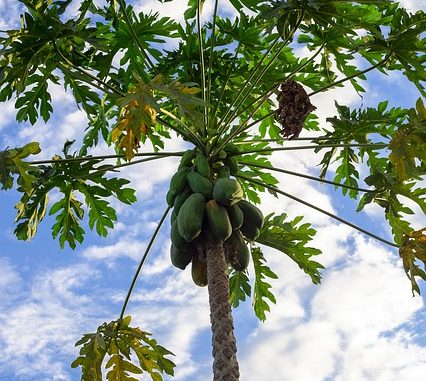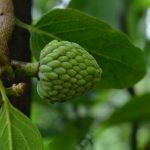
The pawpaw fruit (or papaya as some mistakenly call it) is a North American fruit of great taste and quality. You’ve probably never heard of it but you have certainly tasted it in cuisine from that continent where they make great play of its distinctive flavour.
The fruit is cultivated in the warmer states of the USA and Mexico. Incidentally, papaya is actually a tropical fruit grown in Central America but has been confused with pawpaw over the years.
It is packed full of nutrients as well as having a deliciously sweet flavour and creamy texture. Some folks think the taste is a cross between banana, pineapple and mango. What is more it comes with a remarkable checklist of nutrients benefits which puts it in the same league as a pineapple.
The Pawpaw Fruit
The scientific name of this fruit is Asimina triloba Dunal. Coming in a up to 6 inches (nearly 15 cm) in length, it is the largest edible fruit native to North America. The skin is deep green when young and unripe but turns yellow before appearing dark brown when fully ripe. The flesh is a pale, almost translucent yellow with sizeable, brown and black seeds. It belongs to the Annonaceae family which also includes the custard apples such as the Annona species of the Soursop and Sugar Apple as well as Cherimoya fruits. It’s a huge genera of 130 with well over 2,300 species and there are still many types related to pawpaw to be discovered.
The tree is grown mostly on the eastern seaboard of the USA as far as Canada but it also happily thrives into the mid-west of the continent. The fruit was and still is to some extent a food of many native tribes in the USA. It prefers to grow along stream banks and is often providing a flowering display in New York right through to the pan handle of Florida.
Cultivars And Varieties
There are a number of varieties and cultivars of pawpaw tree, with their own particular flavour, appearance and texture. The varieties that are cultivated include Davis, Mary Foos Johnson, Mitchel, Rappahannock, Rebecca’s Gold, Shenandoah, Sunflower, Susquehanna and Taylor.
Compounds In the Fruit
The fruit has been analysed and found to contain the following (Shiota, 1991):
ethyl esters (hexanoate, 50.2%; octnoate, 19.3%, butanoate, 8.5%, and decanoate, 1.3%), a few methyl esters, butane-2,3-diol mmonoesters and acetoin.
Nutrition
Pawpaw fruit contains plenty of useful nutrients, including minerals like copper, iron, magnesium and manganese.
A standard amount of fruit (3.5 ounces (100 grams)) of pawpaw fruit contains the following nutrients based on various reference sources:
- 80 calories
- 1 gram fat
- 19 grams carbohydrates
- 1 gram protein
- 2.5 grams dietary fiber
- 63 milligrams calcium (5 percent DV)
- 2.6 milligrams manganese (113 percent DV)
- 0.5 milligrams copper (56 percent DV)
- 7 milligrams iron (39 percent DV)
- 113 milligrams magnesium (27 percent DV)
- 0.9 milligrams zinc (8 percent DV)
- 345 milligrams potassium (7 percent DV)
- 18.3 milligrams vitamin C (20 percent DV)
- 0.09 milligrams riboflavin (7 percent DV)
- 1.1 milligrams niacin (7 percent DV)
A few other nutrients have also been measured which includes vitamin A, phosphorus and thiamine.
Could There Be Benefits In Cancer Treatment ?
The family of the Annonaceae have provided us with many different types of fruit that potentially might provide compounds with tumour suppressing activity. Generally, great interest has been shown in acetogenenins which in their own right show different activities against cancerous cells (McLaughin, 2008).
References
McLaughlin, J. L. (2008). Paw paw and cancer: annonaceous acetogenins from discovery to commercial products. Journal of Natural Products, 71(7), pp. 1311-1321. (Article)
Shiota, H. (1991). Volatile components of pawpaw fruit (Asimina triloba Dunal). Journal of Agricultural and Food Chemistry, 39(9), pp. 1631-1635. (Article)



Leave a Reply